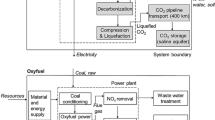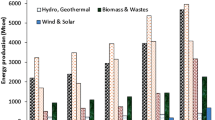Abstract
Global warming may be slowed down by carbon capture and storage systems that allow to sequester carbon dioxide from large fixed point sources such as power plants or industrial facilities that use fossil fuels or biomass as fuel. Nonetheless, these processes often consume a lot of energy and materials, and they emit pollutants. In particular, monoethanolamine regeneration after carbon dioxide absorption is energy-intensive. Alternatively, membrane separation presumably consumes less energy than absorption, yet there is no reported quantitative comparison. Here we compared monoethanolamine absorption and two-stage membrane separation for carbon dioxide separation in a supercritical pulverized coal power plant, using life cycle assessment. We considered 13 midpoint impact categories including global warming, ozone depletion, freshwater eutrophication, marine eutrophication, terrestrial acidification, fossil resource depletion, water resource depletion, metal depletion, terrestrial ecotoxicity, freshwater ecotoxicity, marine ecotoxicity, human toxicity and particulate matter formation. Results show that membrane separation is 5% more efficient and requires 11.6% less energy than monoethanolamine absorption. Membrane separation has also lower environmental impact scores versus monoethanolamine absorption, such as 0.495 versus 0.546 for global warming, 0.219 versus 0.243 for human toxicity and 0.284 versus 0.318 for fossil depletion. Overall, the two-stage membrane separation should induce less damage to ecosystems, human health and resources.


Similar content being viewed by others
References
Bicalho T, Sauer I, Rambaud A, Altukhova Y (2017) LCA data quality: a management science perspective. J Clean Prod 156:888–898. https://doi.org/10.1016/j.jclepro.2017.03.229
Chao C, Deng Y, Dewil R et al (2021) Post-combustion carbon capture. Renew Sustain Energy Rev 138:110490. https://doi.org/10.1016/j.rser.2020.110490
Clarens F, Espí JJ, Giraldi MR et al (2016) Life cycle assessment of CaO looping versus amine-based absorption for capturing CO2 in a subcritical coal power plant. Int J Greenh Gas Control 46:18–27. https://doi.org/10.1016/j.ijggc.2015.12.031
da Cruz TT, Perrella Balestieri JA, de Toledo Silva JM et al (2021) Life cycle assessment of carbon capture and storage/utilization: from current state to future research directions and opportunities. Int J Greenh Gas Control 108:103309. https://doi.org/10.1016/j.ijggc.2021.103309
Fadeyi S, Arafat HA, Abu-Zahra MRM (2013) Life cycle assessment of natural gas combined cycle integrated with CO2 post combustion capture using chemical solvent. Int J Greenh Gas Control 19:441–452. https://doi.org/10.1016/j.ijggc.2013.10.008
Fawzy S, Osman AI, Doran J, Rooney DW (2020) Strategies for mitigation of climate change: a review. Environ Chem Lett 18:2069–2094. https://doi.org/10.1007/s10311-020-01059-w
Goglio P, Williams AG, Balta-Ozkan N et al (2020) Advances and challenges of life cycle assessment (LCA) of greenhouse gas removal technologies to fight climate changes. J Clean Prod 244:118896. https://doi.org/10.1016/j.jclepro.2019.118896
Khalilpour R, Mumford K, Zhai H et al (2015) Membrane-based carbon capture from flue gas: a review. J Clean Prod 103:286–300. https://doi.org/10.1016/j.jclepro.2014.10.050
Matin NS, Flanagan WP (2022) Life cycle assessment of amine-based versus ammonia-based post combustion CO2 capture in coal-fired power plants. Int J Greenh Gas Control 113:103535. https://doi.org/10.1016/j.ijggc.2021.103535
Nie Z, Korre A, Durucan S (2011) Life cycle modelling and comparative assessment of the environmental impacts of oxy-fuel and post-combustion CO2 capture, transport and injection processes. Energy Procedia 4:2510–2517. https://doi.org/10.1016/j.egypro.2011.02.147
Raganati F, Miccio F, Ammendola P (2021) Adsorption of carbon dioxide for post-combustion capture: a review. Energy Fuels 35:12845–12868. https://doi.org/10.1021/acs.energyfuels.1c01618
Saunier F, Fradette S, Clerveaux F et al (2019) Comparison of life-cycle assessment between bio-catalyzed and promoted potassium carbonate processes and amine-based carbon capture technologies. Int J Greenh Gas Control 88:134–155. https://doi.org/10.1016/j.ijggc.2019.05.009
Schakel W, Meerman H, Talaei A et al (2014) Comparative life cycle assessment of biomass co-firing plants with carbon capture and storage. Appl Energy 131:441–467. https://doi.org/10.1016/j.apenergy.2014.06.045
Sharma H, Dhir A (2021) Capture of carbon dioxide using solid carbonaceous and non-carbonaceous adsorbents: a review. Environ Chem Lett 19:851–873. https://doi.org/10.1007/s10311-020-01118-2
Terlouw T, Bauer C, Rosa L, Mazzotti M (2021) Life cycle assessment of carbon dioxide removal technologies: a critical review. Energy Environ Sci 14:1701–1721. https://doi.org/10.1039/D0EE03757E
Tiruta-Barna L (2021) A climate goal-based, multicriteria method for system evaluation in life cycle assessment. Int J Life Cycle Assess 26:1913–1931. https://doi.org/10.1007/s11367-021-01991-1
Troy SV, Wagner H-J (2011) Screening life cycle analysis of post combustion CO2 -capture technologies–a comparison of construction phase results. Energy Procedia 4:480–487. https://doi.org/10.1016/j.egypro.2011.01.078
Troy S, Schreiber A, Zapp P (2016) Life cycle assessment of membrane-based carbon capture and storage. Clean Techn Environ Policy 18:1641–1654. https://doi.org/10.1007/s10098-016-1208-x
Vega F, Sanna A, Navarrete B et al (2014) Degradation of amine-based solvents in CO2 capture process by chemical absorption. Greenh Gases: Sci Technol 4:707–733. https://doi.org/10.1002/ghg.1446
Wang Y, Zhao L, Otto A et al (2017) A review of post-combustion CO2 capture technologies from coal-fired power plants. Energy Procedia 114:650–665. https://doi.org/10.1016/j.egypro.2017.03.1209
Wang J, Wang R, Zhu Y, Li J (2018) Life cycle assessment and environmental cost accounting of coal-fired power generation in China. Energy Policy 115:374–384. https://doi.org/10.1016/j.enpol.2018.01.040
Wang Y, Pan Z, Zhang W et al (2022) Life cycle assessment of combustion-based electricity generation technologies integrated with carbon capture and storage: a review. Environ Res 207:112219. https://doi.org/10.1016/j.envres.2021.112219
Wei X, Manovic V, Hanak DP (2020) Techno-economic assessment of coal- or biomass-fired oxy-combustion power plants with supercritical carbon dioxide cycle. Energy Convers Manag 221:113143. https://doi.org/10.1016/j.enconman.2020.113143
Yadav P, Ismail N, Essalhi M et al (2021) Assessment of the environmental impact of polymeric membrane production. J Membr Sci 622:118987. https://doi.org/10.1016/j.memsci.2020.118987
Zhang X, Singh B, He X et al (2014) Post-combustion carbon capture technologies: energetic analysis and life cycle assessment. Int J Greenh Gas Control 27:289–298. https://doi.org/10.1016/j.ijggc.2014.06.016
Acknowledgements
This work is partially supported by Liaoning Provincial Doctoral Research Startup Fund Project (2019-BS-159), Liaoning Provincial Department of Education Key Research Project (L2020002) and Scientific Research Fund Project of Education Department of Liaoning Province (LJKZ0381).
Author information
Authors and Affiliations
Corresponding authors
Ethics declarations
Conflict of interest
The authors declare no conflict of interest.
Additional information
Publisher's Note
Springer Nature remains neutral with regard to jurisdictional claims in published maps and institutional affiliations.
Supplementary Information
Below is the link to the electronic supplementary material.
Rights and permissions
Springer Nature or its licensor (e.g. a society or other partner) holds exclusive rights to this article under a publishing agreement with the author(s) or other rightsholder(s); author self-archiving of the accepted manuscript version of this article is solely governed by the terms of such publishing agreement and applicable law.
About this article
Cite this article
Wang, Y., Pan, Z., Zhang, W. et al. Higher efficiency and lower environmental impact of membrane separation for carbon dioxide capture in coal power plants. Environ Chem Lett 21, 1951–1958 (2023). https://doi.org/10.1007/s10311-023-01596-0
Received:
Accepted:
Published:
Issue Date:
DOI: https://doi.org/10.1007/s10311-023-01596-0




